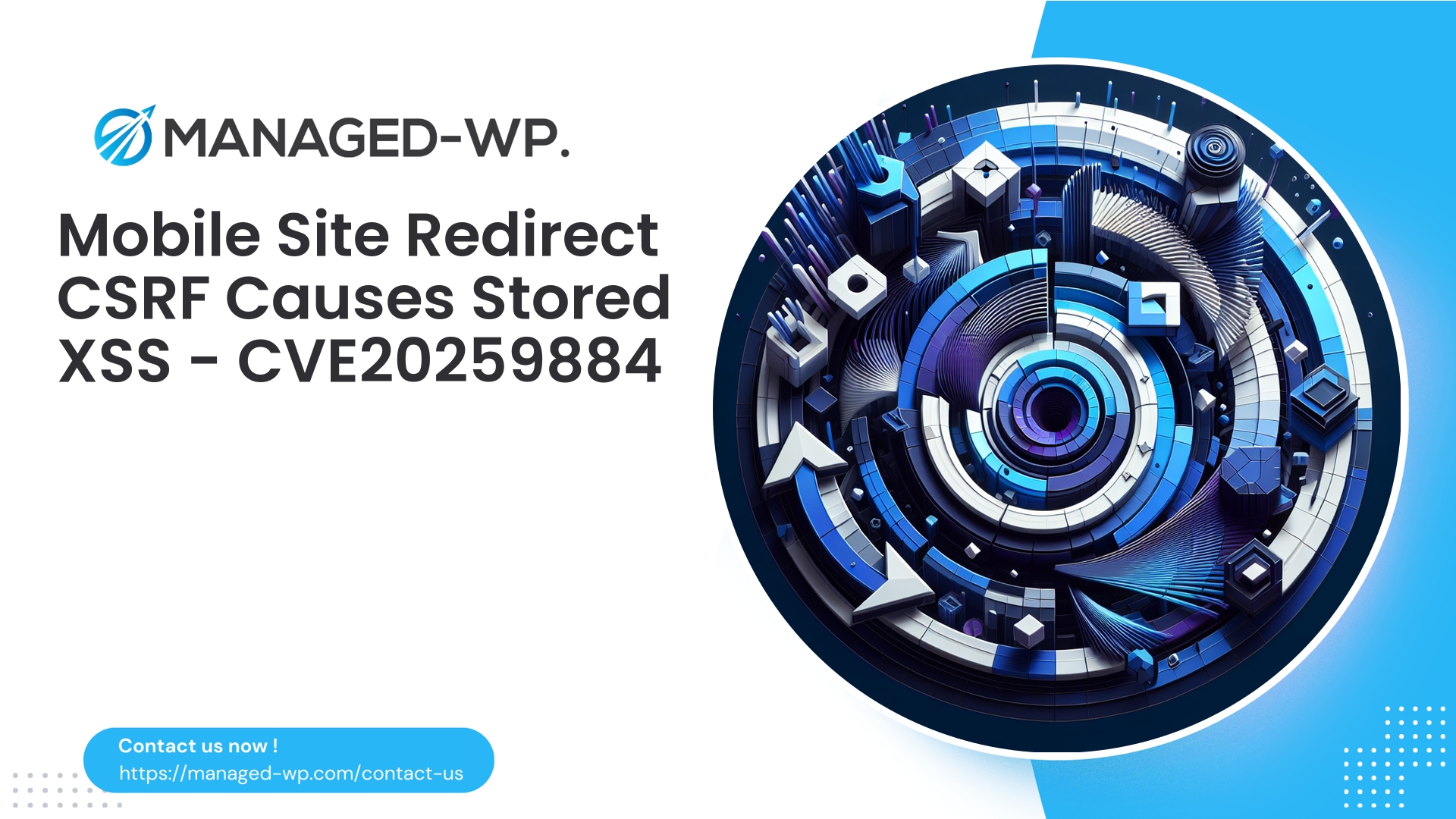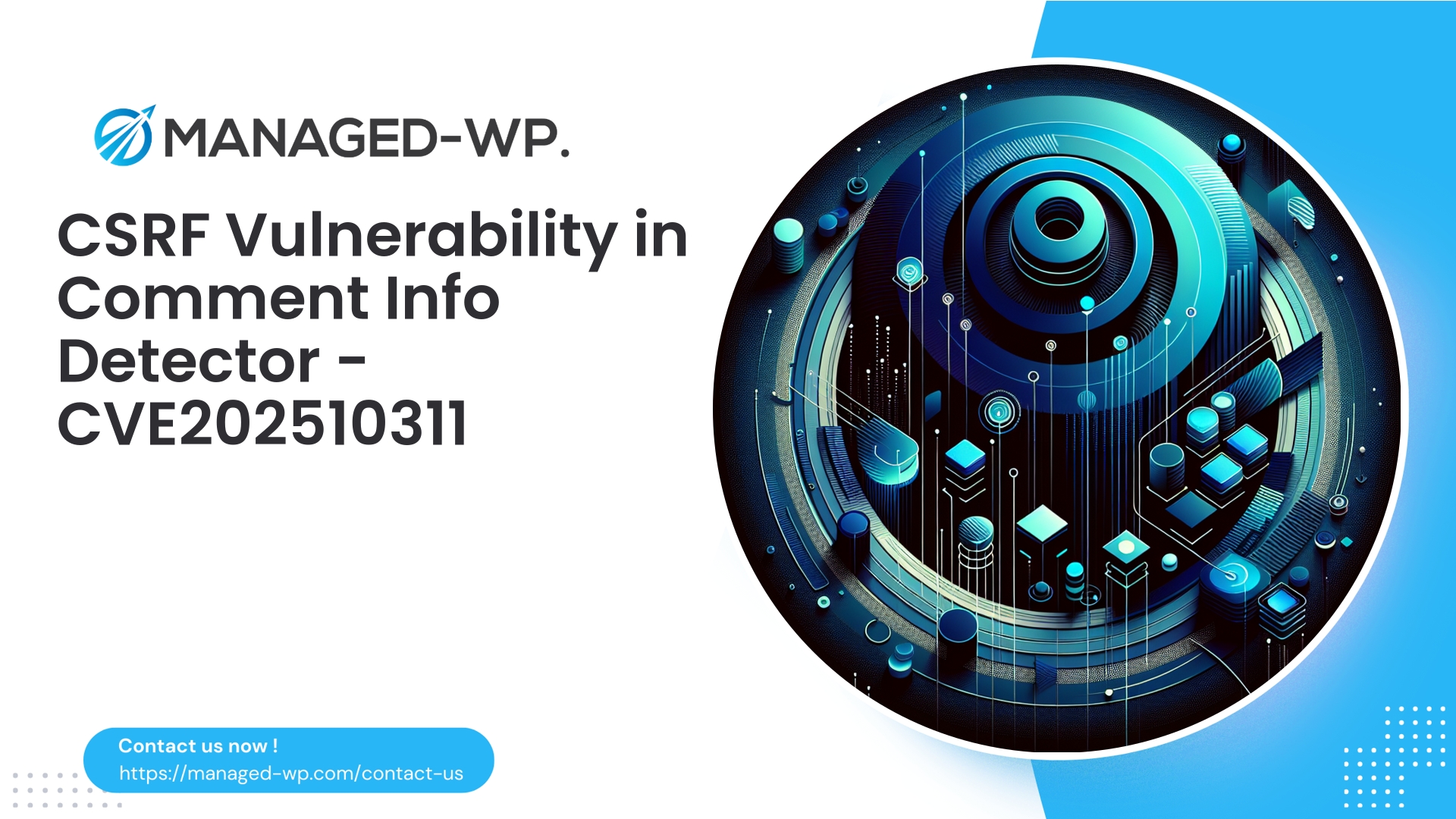| 插件名称 | 移动网站重定向 |
|---|---|
| 漏洞类型 | 跨站请求伪造 (CSRF) |
| CVE编号 | CVE-2025-9884 |
| 紧急 | 低的 |
| CVE 发布日期 | 2025-10-03 |
| 源网址 | CVE-2025-9884 |
紧急安全公告:CVE-2025-9884 — 移动网站重定向 (≤ 1.2.1) — CSRF 漏洞导致存储型 XSS 漏洞
发布日期:2025年10月3日
在 Managed-WP,我们的使命是为 WordPress 网站所有者和开发者提供关于新兴安全威胁的及时、专业的见解。最近披露的一个漏洞影响了 Mobile Site Redirect 插件(版本 ≤ 1.2.1),该漏洞已被公开编入 CVE-2025-9884。此漏洞结合了跨站请求伪造 (CSRF) 和存储型跨站脚本 (XSS) 攻击,使攻击者能够通过被入侵的特权用户操作注入恶意 JavaScript 代码。其结果是:持久性脚本在管理后台和前端页面中执行,对网站完整性构成严重威胁。
这份全面的安全指南解释了该漏洞的技术机制、潜在的实际影响、检测策略、即时缓解方案(包括通过 Web 应用防火墙 (WAF) 进行虚拟修补)以及长期的安全加固指导。我们还提供了具体的命令和示例防火墙规则,可立即部署。
TL;DR — 现在必须理解的关键点
- 移动站点重定向插件(版本≤1.2.1)存在 CSRF 漏洞,可导致存储型 XSS 注入。
- CVE-2025-9884 于 2025 年 10 月 3 日公开披露。
- 利用此漏洞需要诱骗具有管理员权限的已登录用户发出精心构造的请求,从而导致恶意脚本永久存储。
- 可能的影响包括凭证被盗、网站完全被接管、SEO垃圾邮件插入、未经授权的重定向和持久性后门。
- 截至披露时,尚无官方补丁可用。
- 立即采取的措施包括停用插件、应用 WAF 虚拟补丁、扫描和清理数据库、轮换密钥和盐值,以及彻底的事件响应。
了解漏洞——技术分析
出现此问题的原因是该插件在关键管理端点上缺乏适当的访问控制和 CSRF 保护,再加上对存储的数据清理不足。
- 该插件公开了接受用户输入的管理员操作或设置页面(例如,重定向规则、自定义消息)。
- 这些端点未能强制执行 CSRF 保护措施,例如 nonce 验证或能力检查,从而允许攻击者控制的页面代表经过身份验证的管理员伪造 POST 请求。
- 包含 JavaScript 有效载荷的输入数据直接存储在数据库中,而没有进行充分的清理或编码。
- 如果在管理界面或前端渲染时没有进行适当的转义,则存储的数据会作为恶意 JavaScript 执行——从而造成存储型 XSS 攻击。
存储型 XSS 执行会使网站遭受反复攻击,影响任何查看受影响页面的用户,包括敏感的管理功能。
不安全的编码示例通常如下所示:
// 不安全:缺少 nonce、用户权限检查和输入清理 if ( isset($_POST['mobile_redirect_settings']) ) { update_option( 'mobile_redirect_settings', $_POST['mobile_redirect_settings'] ); }
安全编码必须包含:
- 验证 WordPress nonce(
wp_verify_nonce())适用于所有 POST 请求。 - 能力检查
当前用户可以()确保只有授权用户才能修改设置。 - 使用诸如以下函数在保存时对输入进行清理,并在输出时进行转义:
sanitize_text_field(),esc_attr(),esc_html(), 或者wp_kses_post().
影响评估——攻击者可能达到的目标
存储型 XSS 有效载荷可用于多种恶意活动,例如:
- 通过窃取 cookie 或 token 来劫持管理员或用户会话。
- 在控制面板内执行未经授权的管理操作。
- 植入额外的后门或恶意定时任务(例如,通过 WP-Cron)。
- 在正式网站上注入垃圾内容、钓鱼页面或恶意重定向。
- 向访客部署加密货币挖矿脚本或其他有害载荷。
- 秘密窃取敏感网站或用户数据。
尽管公开评分将此漏洞标记为 低紧急程度实际风险很高(披露文件中指出CVSS评分为7.1)。CSRF与持续性XSS相结合通常会导致严重的现实安全事件。
哪些人面临风险?
- 任何安装了 Active Mobile Site Redirect 插件版本 ≤ 1.2.1 的 WordPress 安装。
- 插件的设置端点必须可访问;停用的插件被利用的可能性较小,但仍然存在残余风险。
- 网站管理员或拥有较高权限的用户可能会被诱骗访问攻击者控制的页面。
- 网站在前端或后台页面渲染插件配置数据时未进行输出转义。
检测——识别剥削迹象
如果您使用此插件,请立即采取行动,检查是否存在正在进行或已经发生的漏洞利用:
- 搜索 WordPress 数据库,查找注入的脚本标签或可疑的事件处理程序:
# 在 wp_options 表中查找可疑条目,wp 数据库查询语句为“SELECT option_id, option_name FROM wp_options WHERE option_value LIKE '%'”。
- 扫描上传文件和主题目录,查找包含可疑脚本或执行函数的近期文件:
# 从 WordPress 根目录查找 wp-content/uploads -type f -mtime -30 -print | xargs grep -I -n "
- 检查最近 30 天内修改过的文件:
查找 . -type f -mtime -30 -printf '%TY-%Tm-%Td %TT %p ' | sort -r
- 查看管理员活动日志和 Web 服务器访问日志,查找异常的 POST 请求或可疑的引用来源。
- 检查用户帐户是否存在可疑的添加或权限提升。
- 使用可信插件或服务器端扫描器运行全面的恶意软件扫描。
您可以立即采取的缓解措施
如果无法立即升级或打补丁(目前没有官方补丁可用),请优先执行以下操作:
- 停用或移除存在漏洞的插件 消除攻击途径。
- 通过 Web 应用程序防火墙 (WAF) 应用虚拟补丁 阻止攻击尝试,重点关注针对插件端点的恶意载荷 POST 请求。
- 实现 Web 服务器级请求过滤 当 WAF 不可用时,阻止包含脚本标签或 XSS 模式的可疑 POST 请求。
nginx 配置示例片段:
location ~* /wp-admin/(admin-post\.php|options\.php|.*mobile-site-redirect.*) { if ($request_method = POST) { set $block 0; if ($http_referer !~* "^https?://(example\.com|www\.example\.com)/") { set $block 1; } if ($request_body ~* "
mod_security(Apache)示例代码片段:
SecRule REQUEST_URI "@contains mobile-site-redirect" "phase:2,chain,deny,status:403,log,msg:'阻止了移动站点重定向漏洞利用尝试'" SecRule REQUEST_BODY "(?i)(
笔记: 这些快速修复方法可能会导致误报,需要在生产部署前进行测试。
- 暂时限制对管理页面的访问: 将 wp-admin 列入 IP 白名单或实施 HTTP 基本身份验证。
强制管理员重置密码并轮换安全密钥和盐值。 - 增强浏览器安全性: 利用 HTTP 严格传输安全 (HSTS)、安全 cookie 标志和内容安全策略 (CSP) 来降低 XSS 影响。
用于阻止漏洞利用的 WAF 规则逻辑示例
Managed-WP 客户可受益于我们精心设计的 WAF 规则,这些规则能够立即阻止此类威胁。概念规则包括:
- 触发针对与移动网站重定向插件关联的管理端点的 POST 请求。
- 阻止缺少有效 WordPress nonce 令牌或来源可疑的请求。
- 阻止包含 JavaScript 有效负载指示器的请求,例如
<script事件处理程序或编码有效载荷。
伪规则摘要:
- 如果 URI 包含
移动网站重定向或者操作=msr_save_settings - 请求方法为 POST
- 并且(请求正文包含)
<script或者错误=或者 HTTP Referer 无效或缺少 nonce 标头) - 然后以状态码 403 阻止请求并通知管理员。
请随时联系 Managed-WP,立即为您的网站激活此类保护措施。
清理已存储的 XSS 有效载荷 — 事件响应清理
如果发生了剥削行为,应采取系统的补救措施:
- 完整备份您的网站 (数据库和文件),在更改之前离线存储。
- 识别并消除数据库选项中注入的脚本标签:
# 清理选项表中的脚本标签(谨慎处理)wp 数据库查询“UPDATE wp_options SET option_value = REPLACE(option_value, '
- 以类似方式清理文章内容和元字段:
# 文章 wp 数据库查询“UPDATE wp_posts SET post_content = REPLACE(post_content, '
重要的: 在进行全面更换之前,务必进行仔细的人工检查。复杂的有效载荷需要专业的 HTML 解析和清理技术。
- 删除攻击者添加的恶意管理员帐户、帖子或计划任务。
- 轮换 WordPress 身份验证密钥和盐值
wp-config.php强制所有用户重新进行身份验证。 - 请仅从可信来源重新安装 WordPress 核心文件、主题和插件。
- 扫描文件系统,查找未经授权的 PHP 文件、webshell 和脚本;删除可疑项目。
- 如果可以,请从入侵前已知的干净备份中恢复。
如果内部专业知识有限,请聘请专业的事故响应服务公司进行彻底的清理和恢复。
开发者指南——防止类似漏洞
插件和主题开发者必须采取严格的安全控制措施:
- 验证所有状态更改请求中的 WordPress nonce:
if ( ! isset( $_POST['my_plugin_nonce'] ) || ! wp_verify_nonce( $_POST['my_plugin_nonce'], 'my_plugin_action' ) ) { wp_die( '安全检查失败' ); }
- 在处理请求之前,请检查当前用户是否具备必要的权限:
if ( ! current_user_can( 'manage_options' ) ) { wp_die( '权限不足' ); }
- 保存前请对所有输入内容进行清理和验证:
- 使用类似这样的功能
sanitize_text_field(),sanitize_textarea_field(),esc_url_raw(),sanitize_email(), 或者intval(). - 对于 HTML 输入,通过以下方式将标签和属性列入白名单:
wp_kses(). - 使用适当的转义规则转义所有输出
esc_attr(),esc_html(),esc_textarea(), 或者wp_kses_post(). - 尽可能避免存储未经信任的原始HTML代码。
- 如果要以编程方式公开设置,请使用带有适当权限回调和 nonce 验证的 REST 或 Ajax 端点。
长期修复和加固检查清单
- 官方修复程序发布后,请立即移除或升级存在漏洞的插件。
- 如果问题没有得到解决,请用安全的替代方案或经过验证的自定义代码替换插件功能。
- 对所有管理员用户强制执行多因素身份验证。
- 尽可能通过 IP 地址隐式限制管理员访问权限,或者使用 VPN 或 HTTP 身份验证进行保护。
- 定期备份您的网站并测试恢复程序。
- 安排例行文件完整性和安全监控扫描。
- 如果管理多个站点,请启用日志记录并与安全信息和事件管理 (SIEM) 系统集成。
- 实施并调整稳健的内容安全策略 (CSP),以降低 XSS 风险。
- 保持 WordPress 核心、主题、插件、PHP 和服务器软件处于最新状态。
如果您怀疑您的网站已被入侵——事件响应步骤
- 遏制: 停用存在漏洞的插件,限制管理员权限,部署紧急WAF规则。
- 证据保存: 安全备份日志和网站数据,不得进行任何修改。
- 范围评估: 识别已修改的用户、文件、数据库条目和计划任务。
- 根除: 清除后门和恶意代码;清理受影响的数据。
- 恢复: 轮换密码和密钥;根据需要从干净的备份中恢复。
- 事件后: 分析根本原因,修复漏洞,并通知相关人员。
常见问题
问:我的移动网站重定向插件已停用。我的网站仍然存在安全漏洞吗?
答:如果停用,立即遭受攻击的风险会降低,但存储的恶意载荷可能仍然存在。此外,某些插件即使在不活动状态下也会暴露端点。请确认插件状态,并在不需要时将其移除。
问:我的CDN能抵御这种攻击吗?
答:虽然 CDN 可以减少流量并阻止一些可疑请求,但如果没有特定的 WAF 规则,它们并不能保证抵御精心设计的攻击。站点级 WAF 仍然是最有效的即时防御手段。
问:目前还没有官方补丁可用——我该怎么办?
答:在官方修复程序发布之前,使用 WAF 进行虚拟修补、停用插件或替换插件是最安全的选择。
Managed-WP 如何保护您的 WordPress 网站
Managed-WP 提供全面的托管式 Web 应用防火墙 (WAF) 和漏洞防护服务,旨在弥合公开漏洞公告与官方补丁之间的差距。我们的解决方案包括:
- 精心设计的 WAF 规则可阻止对新披露的漏洞的利用尝试,包括 CSRF 和存储型 XSS 攻击链。
- 自动恶意软件检测和清理服务,可删除存储的恶意脚本和文件。
- 重点缓解 OWASP Top 10 漏洞,例如 XSS、CSRF、SQL 注入和访问控制失效。
- 一旦出现零日漏洞,立即快速部署虚拟补丁。
如需立即获得持续保护,请考虑使用 Managed-WP 的套餐。我们的免费套餐提供适用于大多数网站的基本防御功能。
立即保护您的网站——从 Managed-WP 的免费套餐开始
我们的基础(免费)套餐包含托管防火墙、无限带宽、Web 应用防火墙 (WAF)、恶意软件扫描以及针对常见漏洞(例如此处列出的漏洞)的防护。这是立即增强您抵御关键插件漏洞(例如 CVE-2025-9884)的简便方法。立即注册,即可获得即时保护:
https://my.wp-firewall.com/buy/wp-firewall-free-plan/
为了增强保障,我们的标准版和专业版套餐提供高级自动恶意软件清除、IP 管理、每月安全报告、自动虚拟补丁和专属专家支持。
72小时行动清单
- 确定您的网站上是否安装了 Mobile Site Redirect 插件 ≤ 1.2.1;如果已安装,则优先执行操作。
- 立即停用或卸载该插件,以消除风险。
- 如果不能立即移除,请实施 WAF 规则(托管型 WordPress 客户可以立即部署这些规则)以阻止恶意 POST 请求。
- 使用上述检测命令检查您的网站,查找注入的脚本内容。
- 清理网站,删除恶意数据库条目和文件。
- 轮换所有管理凭据、API 密钥,并更新身份验证盐值。
- 密切监控日志和扫描结果,以发现任何再次感染或恶意活动的迹象。
- 计划用维护良好的替代插件替换存在漏洞的插件,或者仅在经过验证的补丁发布后才进行升级。
最后的想法
CSRF 和存储型 XSS 的结合构成严重威胁,它利用受信任的用户会话在 WordPress 网站中引入并维护恶意代码。虽然禁用插件和部署 WAF 虚拟补丁等果断措施可以降低短期风险,但持续的安全防护对于避免未来事件的发生至关重要:
- 对管理角色实施最小权限原则。
- 要求所有管理员访问权限启用多重身份验证。
- 尽量减少已安装插件的数量,并确保它们来自可信来源。
- 采用托管式WAF服务来缩短漏洞暴露窗口期。
- 采用安全开发最佳实践,包括 nonce 验证、能力检查、数据清理和输出转义。
如需事件调查、紧急虚拟补丁部署或全面清理方面的专业协助,Managed-WP 的安全团队随时为您提供支持。立即注册我们的基础(免费)计划,启用基础防护:
https://my.wp-firewall.com/buy/wp-firewall-free-plan/
保持警惕并积极主动——攻击者行动迅速且自动,但有效的控制措施是避免重大损失的关键。



















